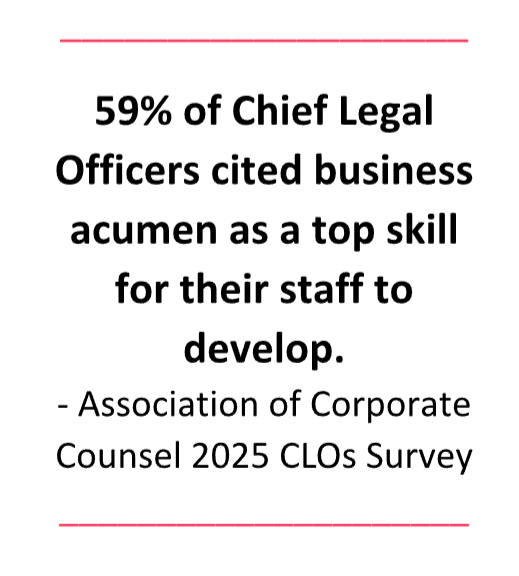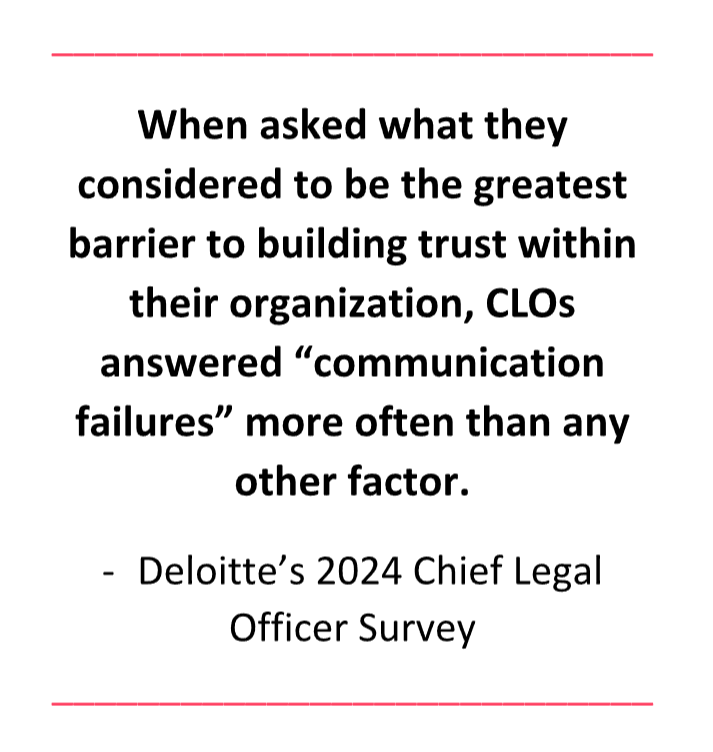As a legal or compliance leader, you’ve likely experienced that moment: you’ve provided carefully considered guidance on a business initiative, only to sense resistance in the room. Perhaps you’ve noticed how a business partner seems to work around you rather than with you. These scenarios, familiar to many in risk management and compliance roles, often point to a fundamental challenge: trust.
Trust is the invisible force that can transform skepticism into productive dialogue, foster collaboration, and enable your guidance to resonate rather than face resistance. It makes stakeholders seek your input early in their planning process rather than as a last-minute checkbox.
But what is trust, and how can you build it with stakeholders when your role involves identifying and mitigating risks, and could impact business strategy?
Understanding Trust in the Legal and Compliance Context
Simply stated, trust is the belief in another person’s abilities, integrity and character. Charles Feltman defines it as: “choosing to risk making something you value vulnerable to another person’s actions.” Trust is undoubtedly emotional at its core.
For legal and compliance leaders, trust enables decisive action even when facing the inevitability of imperfect information. It’s the foundation that allows progress despite the presence of unknowns.
When trust is absent, we feel the effect immediately: discussions become unproductive, information flows selectively, silos emerge, and politics take over. Legal and Compliance teams may feel sidelined, while the business may perceive them as obstacles rather than allies. A low-trust dynamic is challenging and costly for all involved.
- • Early involvement in strategic discussions. Trusted legal and compliance leaders are brought into conversations early, enabling timely, proactive input. This allows legal and regulatory requirements to be built into the product/strategy design from the start, reducing costly adjustments later.
- • Enhanced information flow. Open communication leads to better proactive risk management and fewer crises. When stakeholders trust you, they are more likely to share potential issues early, enabling collaborative problem-solving before challenges escalate.
- • Increased influence on decisions. When navigating complex situations where proposed strategies present a challenging risk profile, trusted legal and compliance leaders find their guidance carries more weight, and the need to escalate issues decreases.
Building Trust: A Framework for Legal and Compliance Leaders
How can we build trust as legal or compliance leaders? Applying the findings of recent research on trust to the reality of legal and compliance leadership, here are seven key trust-building blocks:
Technical expertise is unquestionably foundational to our credibility. However, today’s complex business environment demands “contextual excellence” – the intersection of legal/regulatory expertise, business acumen and strategic foresight. To strengthen credibility with stakeholders, legal and compliance leaders must show an intimate understanding of the business workings, an ability to contextualize risks and offer practical, relevant and tailored solutions.
Business savviness is also expected from the top – according to the Association of Corporate Counsel’s 2025 CLOs Survey, 59% of Chief Legal Officers cited business acumen as a top skill for their staff to develop.

To demonstrate contextual excellence:
- ➤Develop business fluency. Show you understand the business – its products, market and competitive positioning, and the business’ goals, opportunities and challenges. Be proactive in getting up to speed on emerging technologies and strategies the business is considering.
- ➤Show agile and innovative thinking. There is often more than one viable way to move forward compliantly and mitigate potential risks effectively.
- ➤Provide actionable solutions. Go beyond identifying legal risks; contextualize and qualify the risks, and identify and present opportunities and practical solutions.
- ➤Stay ahead of industry developments and trends. Share actionable insights from industry associations, conferences and regulatory bodies with your stakeholders, and help them evaluate potential implications and opportunities.
- ➤Take part in strategic and cross-functional initiatives. It’s an opportunity to broaden your skill set while gaining deeper insights into corporate priorities.
- ➤Exhibit self-trust. If you appear uncertain, stakeholders may hesitate to trust your perspective. Ask yourself: would you follow your own guidance?
2. Cultivate Meaningful Partnerships
In many companies, influence now depends more on relationship capital than positional authority; this is true for legal and compliance leaders as well, which can admittedly be a shift for some.
Trust is relational, not transactional. Have a 360° view of your network:
- Senior leadership you report to and support
- Business units and functional team leaders and their teams
- Peers within your department
- Cross-functional peers and collaborators
- Direct reports
- External contributors and stakeholders
Be intentional in understanding their working styles, priorities and challenges. Also, keep in mind that showing up authentically is key to building meaningful relationships.
To strengthen these partnerships:
- ➤
Create regular touchpoints and maintain open communication. Schedule informal check-ins, walking meetings or virtual coffee breaks with key stakeholders to understand their evolving priorities and challenges.
- ➤
Demonstrate commitment. For instance, attend business strategy sessions – even when legal/regulatory or compliance considerations aren’t on the agenda – to show your investment in understanding the broader company goals.
-
➤
Add value. For example:
- When supporting a new strategy, proactively survey your legal or compliance peers to seek precedents that could inform how the business could consider moving forward.
- Offer to help brainstorm compliant alternatives when the original plan poses risks, signaling your desire to collaborate and consider innovative solutions.
- Share tailored industry insights that connect regulatory developments to specific strategic initiatives.
3. Master the Art of Listening
Effective listening helps build psychological safety and encourages open dialogue about risks and challenges. When stakeholders feel heard, they are more likely to share concerns early and engage in productive risk discussions.
➤ Practice active listening by:
- ✔ Asking open-ended questions to clarify concerns or motivations.
- ✔ Paraphrasing and summarizing to confirm your understanding.
- ✔ Withholding immediate judgment, and remain curious.
- ✔ Listening to understand, not necessarily to respond.
- ✔ Probing deeper by asking “What matters most here?” or “What would success look like?”.
- ✔ Asking how you can be of help.

4. Communicate Effectively
In our era of information abundance, legal and compliance leaders must translate complex information into clear, actionable guidance that empowers informed yet timely decisions and effective action.
According to Deloitte’s 2024 Chief Legal Officer Survey, when asked what they considered to be the greatest barrier to building trust within their organization, CLOs answered “communication failures” more often than any other factor.
To enhance clarity and impact:
Active listening fosters trust by showing empathy and a commitment to collaborative problem-solving.
- ➤
Know your audience. Tailor your communication to your audience and their needs, considering for example the level of details they require, and whether they tend to focus on outcomes versus process. - ➤
Clarify your intent. Intent matters; begin discussions by stating your objective. For instance: “My goal is to help you execute this strategy while managing risks effectively.” - ➤
Use a structured approach. For example, use BLUF (Bottom Line Up Front): state the conclusion first, followed by supporting details. - ➤
Frame your guidance as opportunity. For example, “Here’s how we can achieve this within regulatory boundaries.” - ➤
Be transparent. Acknowledge the uncertainties and limitations in your analysis. Transparency, with demonstrated competence, builds credibility.
5. Conscientiousness: Be Reliable and Consistent
Trust grows when we are sincere, predictable and when others can count on us to deliver reliably.
Trust is built in the small moments as much as the big ones:
- ✔
Set clear expectations. Agree on the deliverables and response times upfront. - ✔
Deliver consistently on commitments. Meet commitments reliably; communicate early if adjustments e.g. to the deadlines are needed, and timely provide alternatives when possible. - ✔
Communicate consistent positions on similar issues.Consistency matters for us individually, but also across the legal or compliance team. Leverage team meetings to have regular alignment discussions with your legal and/or compliance peers, to ensure consistent guidance on similar issues across the businesses and functions.
6. Show Genuine Care and Commitment
While we often prioritize efficiency amid competing demands, it’s important to make time to show we care about the business’ success. Here are ways you can demonstrate genuine commitment and partnership:
- ✔
Celebrate team and business achievements , regardless of the visibility or impact of your involvement. - ✔
Take an active interest in project outcomes and key takeaways, including in projects where your contribution was discreet. - ✔
Proactively seek feedback.Periodically check in with key stakeholders to seek feedback and explore how you can partner more effectively.
7. Extend Trust to Others
This may feel counterintuitive when your role involves risk mitigation; however, extending trust wisely – and within clear boundaries – signals confidence and fosters reciprocal respect.
While trust should not be extended blindly, keep in mind it also needs room to grow – consider leaning towards extending trust unless given a reason not to. When the focus of a discussion shifts from the issue at hand to questioning intent, the dialogue can lose direction and become unproductive. Moreover, if a stakeholder senses your distrust, they will likely find it challenging to trust you in return.
Extending trust also includes finding opportunities to enable autonomy from Legal and Compliance, when it makes sense to approach risk management from a shared understanding and trust basis, rather than on rigid controls.
➤ To enable autonomy:
- ✔Establish clear parameters (along with approved templates and playbooks) for independent decision-making versus required legal or compliance review.
- ✔ Provide risk-assessment frameworks or decision trees, enabling teams to navigate gray areas compliantly and with confidence.
- ✔Provide guardrails rather than rigid rules where appropriate.
- ✔ Recognize and acknowledge demonstrated good judgment and sound understanding of compliance and regulatory considerations.
Putting It Into Action
Building trust takes time, intentionality, and consistency. Take a moment to assess your current approach. You’re likely showing up and engaging effectively in several areas, and there are likely certain behaviors worth refining. As you reflect on the insights shared above, which ones resonate the most with you? Identify a few key actions that would drive meaningful progress, and consider using a simple start/stop/continue framework to guide your next steps:
- Start: What’s one action you can take this week to deepen trust?
- Stop: What’s one behavior that may erode trust that you’d want to stop?
- Continue: What are you already doing well that you should continue?
Final Thoughts
Trust is the cornerstone of effective legal and compliance leadership. It transforms resistance into collaboration, fosters early engagement, and amplifies influence in strategic decision-making. Beyond strengthening relationships and influence, trust is also a catalyst for innovation and agility in an increasingly complex business environment.
When trust thrives, compliance becomes a shared responsibility rather than a mandated obligation, successfully enabling both effective risk management and sustainable business growth, while creating a more engaged and rewarding work experience.
References:
Association of Corporate Counsel. (2025). “2025 ACC Chief Legal Officers Survey”.
Covey, S.M.R. (2018). “The Speed of Trust” (Updated ed.), Free Press.
Deloitte. (2024). “The 2024 Chief Legal Officer Strategy Survey.”
Feltman, C. (2024). “The Thin Book of Trust” (3rd ed.), Berrett-Koehler Publishers, Inc.
Frei F.X. and Morris A. (2020). “Begin with Trust”. Harvard Business Review, May-June 2020.
Zak, P.J. (2017). “The Neuroscience of Trust: Management Behaviors That Foster Employee Engagement.” Harvard Business Review, January-February 2017.
Share this post:

